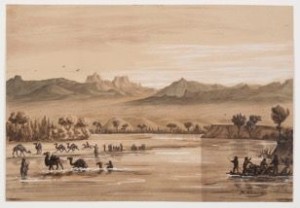By Barbara Patton
By mid-August of 1857, Lieutenant Edward Beale’s surveying party left Albuquerque, heading into Indian country. Traveling ten to twenty miles a day, they arrived at Fort Defiance (just over the border in present-day Arizona) on August 25. From there they closely followed the Whipple expedition's route toward the San Francisco Peaks, and on September 9, Beale recorded, “a plain of vast extent. The viewing of the rich green grass, the distant mountains and our moving camp wagons, sheep, horses and camels made a beautiful picture.”
 On September 10, they encountered the ancient ruins Whipple’s party had seen and the Cosnurio caves. Beale’s guide, Jose Manuel Savedra, seemed perplexed about the route ahead. His confusion increased as they moved west, and by the time they reached the
On September 10, they encountered the ancient ruins Whipple’s party had seen and the Cosnurio caves. Beale’s guide, Jose Manuel Savedra, seemed perplexed about the route ahead. His confusion increased as they moved west, and by the time they reached the mountains, he was completely lost. Beale was furious. By September 14, he turned to his second guide, Lecko, who had traveled with explorer Francis Xavier Aubrey. Lecko advised turning northwest away from Whipple’s trail and following one Aubrey used. Lecko was sent ahead to search for water, but his mule ran off. When the expedition caught up, Lecko admitted he too was lost.
With no water or grass for the horses and mules, Beale sent two men on camels eastward to look for water while he and several men on horses headed west. Not finding water, Beale’s men returned to the main group and found the camel scouts waiting with barrels of water. They reported they had traveled sixteen to twenty miles to the east before the camels led them to a stream where they filled their barrels.
The expedition continued west and, after a day, the weather turned hot and dry. Horses and mules were put on half rations of water and suffered terribly; “the camels alone seemed perfectly indifferent and chewed their cuds in cheerful contentment.” On September 24, they reached a spring. By then most of the animals were in severe distress, while the camels, who had traveled over fifty miles with no water, seemed fine.
They struggled westward and by October, with the help of friendly Mohaves, found a trail leading to the river. At last, “The Colorado was burning in the sunlight about eighteen miles distant.”
Following a foot path down a rocky slope with wagons was difficult, but they were rewarded when they reached the Mohave fields in the river basin. The natives were happy to trade fresh vegetables for the treasures in their wagons.
Crossing the swiftly flowing Colorado River was the next challenge. Beale had brought rubberized pontoons which, when inflated, added buoyancy to the wagons, allowing them to cross easily. Unfortunately, getting horses and mules across the river was not as easy and resulted in the loss of several.
Next was the camels’ turn. No one knew if they could swim. At first, the camels resisted, but Hi Jolly, whispering to one, coaxed him into the water, and the rest followed, swimming “boldly across the rapidly flowing river.”
At this point, Beale had completed his mission of marking a wagon road from Albuquerque to the Colorado River. He would complete the road in two more trips across the 35th parallel. The road became known as the Beale Wagon Road and was later traveled by settlers moving to California. Modern-day Route 66 and I-40 roughly follow the route.
From the Colorado River, Beale followed Whipple’s trail into California. He continued to Fort Tejon and his ranch, where he turned over the camels to his partner, Sam Bishop, for a rest. In November, Beale, Hi Jolly, and a herd of camels marched proudly through the streets of Los Angeles.
Edward Beale was immensely proud of the camels, and the beasts were used again in a few Army endeavors until the Civil War split up the Camel Corps and its supporters. To learn what ultimately happened to the camels and the people in this article, read The Last Camel Charge by Forrest Bryant Johnson.
“Days Past” is a collaborative project of the Sharlot Hall Museum and the Prescott Corral of Westerners International (www.prescottcorral.org). This and other Days Past articles are also available at https://sharlothallmuseum.org/articles/days-past-articles.l. The public is encouraged to submit proposed articles and inquiries to dayspast@sharlothallmuseum.org. Please contact SHM Library & Archives reference desk at 928-445-3122 Ext. 2, or via email at archivesrequest@sharlothallmuseum.org for information or assistance with photo requests.


